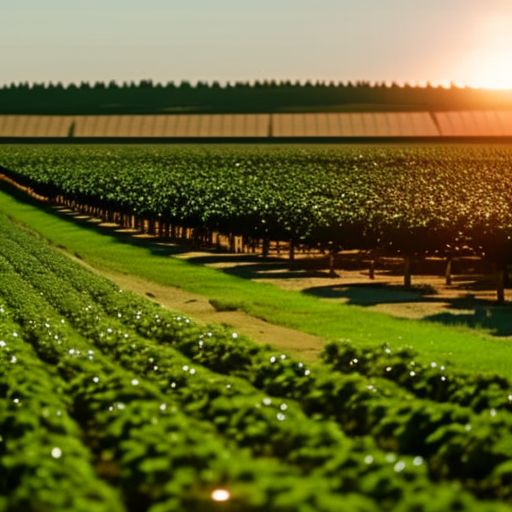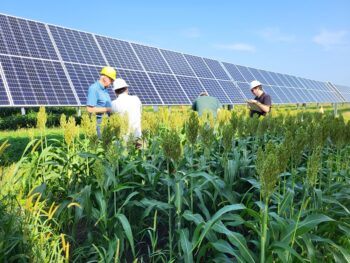
Agrivoltaics: Enhancing Sustainable Food and Energy Production

Agrivoltaics combines traditional solar arrays with agricultural production to generate renewable energy while simultaneously producing food.
Courtesy of Basia Latawiec
Texas A&M AgriLife Researchers Explore Agrivoltaics
Scientists with Texas A&M AgriLife are actively contributing to the research on agrivoltaics, an innovative technology that combines solar energy production with agricultural systems. This approach aims to enhance the efficiency and resiliency of sustainable food and energy production while addressing the increasing demand for electricity in Texas.
As the population of Texas continues to grow, the availability of land for agricultural production is becoming limited. At the same time, the state’s expanding energy requirements pose challenges for energy production. Agrivoltaics offers a solution by integrating traditional solar arrays with agricultural activities, allowing for the simultaneous generation of renewable energy and food production.
Enhancing Land Use with Agrivoltaics
Agrivoltaics is a dual land-use system that combines crop and livestock production with solar power arrays. By implementing agrivoltaics, each acre of land can become more profitable for landowners and agricultural operations, providing a dual-income stream from food and energy production. Research has shown that planting agricultural crops under solar panels can enhance land productivity by up to 60% compared to monocultures or standalone solar panel arrays.
Furthermore, agrivoltaics can offset negative impacts associated with widespread solar array implementation, such as biodiversity loss and increased local temperatures. The vegetation planted under solar arrays provides shade, reducing heat stress for livestock and decreasing soil water evaporation and plant transpiration, resulting in water savings in irrigation.
Carbon Accrual and Biodiversity Benefits
Agrivoltaics also has the potential to increase carbon sequestration through above- and below-ground plant biomass. However, the impact on carbon accrual depends on factors such as prior land use, plant species used, soil types, and agricultural practices. Strategic management of vegetation under the arrays, including the restoration of native vegetation and planting pollinator-friendly species, can also enhance biodiversity.
Challenges and Future Research
While agrivoltaics offers numerous benefits, its implementation involves significant upfront capital costs and long-term investment. Questions regarding large-scale infrastructure, energy storage and transmission, energy pricing, ideal crop selection, solar array configuration, and policy support need to be addressed to make agrivoltaics competitive and attractive for farmers.
Researchers at Texas A&M AgriLife are working to answer these questions through cross-disciplinary research. By exploring the potential of agrivoltaics, they aim to contribute to the achievement of the Sustainable Development Goals (SDGs), particularly SDG 7 (Affordable and Clean Energy) and SDG 2 (Zero Hunger).
SDGs, Targets, and Indicators
-
SDG 7: Affordable and Clean Energy
- Target 7.2: Increase substantially the share of renewable energy in the global energy mix
- Indicator 7.2.1: Renewable energy share in the total final energy consumption
-
SDG 2: Zero Hunger
- Target 2.4: Ensure sustainable food production systems and implement resilient agricultural practices
- Indicator 2.4.1: Proportion of agricultural area under productive and sustainable agriculture
-
SDG 15: Life on Land
- Target 15.1: By 2020, ensure the conservation, restoration, and sustainable use of terrestrial and inland freshwater ecosystems and their services
- Indicator 15.1.2: Proportion of important sites for terrestrial and freshwater biodiversity that are covered by protected areas, by ecosystem type
- Indicator 15.1.3: Proportion of land that is degraded over total land area
The article discusses the concept of agrivoltaics, which combines traditional solar arrays with agricultural production. This concept addresses the need for affordable and clean energy (SDG 7) by utilizing renewable energy sources such as solar power. It also contributes to sustainable food production systems and resilient agricultural practices (SDG 2) by enhancing land productivity and allowing for dual-income streams from food and energy production. Additionally, agrivoltaics can have positive impacts on biodiversity and carbon sequestration, aligning with the goals of conserving terrestrial and freshwater ecosystems (SDG 15).
Based on the article’s content, the specific targets that can be identified are:
- Target 7.2: Increase substantially the share of renewable energy in the global energy mix
- Target 2.4: Ensure sustainable food production systems and implement resilient agricultural practices
- Target 15.1: By 2020, ensure the conservation, restoration, and sustainable use of terrestrial and inland freshwater ecosystems and their services
The article mentions several indicators that can be used to measure progress towards these targets:
- Indicator 7.2.1: Renewable energy share in the total final energy consumption
- Indicator 2.4.1: Proportion of agricultural area under productive and sustainable agriculture
- Indicator 15.1.2: Proportion of important sites for terrestrial and freshwater biodiversity that are covered by protected areas, by ecosystem type
- Indicator 15.1.3: Proportion of land that is degraded over total land area
The article provides evidence that agrivoltaics can enhance land productivity by up to 60% compared to crop monocultures or solar panel arrays on the same land area, indicating progress towards Target 2.4.1. It also mentions the potential positive impact of agrivoltaics on biodiversity and carbon sequestration, which can be measured using Indicator 15.1.2 and Indicator 15.1.3.
| SDGs | Targets | Indicators |
|---|---|---|
| SDG 7: Affordable and Clean Energy | Target 7.2: Increase substantially the share of renewable energy in the global energy mix | Indicator 7.2.1: Renewable energy share in the total final energy consumption |
| SDG 2: Zero Hunger | Target 2.4: Ensure sustainable food production systems and implement resilient agricultural practices | Indicator 2.4.1: Proportion of agricultural area under productive and sustainable agriculture |
| SDG 15: Life on Land | Target 15.1: By 2020, ensure the conservation, restoration, and sustainable use of terrestrial and inland freshwater ecosystems and their services | Indicator 15.1.2: Proportion of important sites for terrestrial and freshwater biodiversity that are covered by protected areas, by ecosystem type |
| SDG 15: Life on Land | Target 15.1: By 2020, ensure the conservation, restoration, and sustainable use of terrestrial and inland freshwater ecosystems and their services | Indicator 15.1.3: Proportion of land that is degraded over total land area |
Copyright: Dive into this article, curated with care by SDG Investors Inc. Our advanced AI technology searches through vast amounts of data to spotlight how we are all moving forward with the Sustainable Development Goals. While we own the rights to this content, we invite you to share it to help spread knowledge and spark action on the SDGs.
Fuente: today.tamu.edu

Join us, as fellow seekers of change, on a transformative journey at https://sdgtalks.ai/welcome, where you can become a member and actively contribute to shaping a brighter future.





